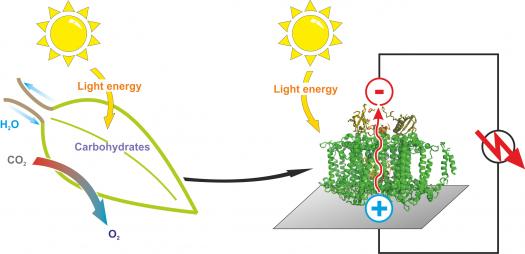Synthetic photosynthesis surpasses nature in PV potential

A cooperation between chemists and biologists from the Ruhr-University Bochum resulted in a new method for the very efficient integration of photosynthetic proteins in photovoltaics. Their recent report in Chemistry - a European journal, selected as a very important paper (VIP) by the journal, offers a new immobilization strategy that yields electron transfer rates exceeding for the first time rates observed in natural photosynthesis. This discovery opens the possibility for the construction of semi-artificial leaves functioning as photovoltaic devices with drastically increased performance.
In leaves, photosystem 1 (PS1) absorbs light and its energy is finally utilized for the conversion of carbon dioxide to biomass. Photovoltaic devices, mostly build from silicon based semiconductors, also harness solar light but produce electricity. One approach for the development of cheaper and renewable photovoltaics consists in replacing the semi-conductor with the isolated membrane protein complexes of photosynthesis. Prof. Dr. Matthias Rögner's team isolates a highly stable PS1 from thermophilic cyanobacteria that live in a hot spring in Japan. However, the integration of this natural component into artificial devices faces one major challenge. PS1 displays both hydrophilic and hydrophobic domains which complicate its immobilization on electrodes.
Dr. Nicolas Plumeré's and Prof. Dr. Wolfgang Schuhmann's teams develop complex electron-conducting materials, so-called redox hydrogels, with stimuli responsive properties. The researchers embedded PS1 in this artificial matrix and where able to fine tune the local environment of the natural photosynthetic proteins. The hydrophobic/hydrophilic properties of the hydrogel can be controlled by pH shift and were adjusted to the hydrophobic requirement of the photosystem. This purpose-built environment provides the optimal conditions for PS1 and overcomes the kinetic limiting steps, which are found in natural leaves. This procedure yields the highest photocurrents observed to date for semi-artificial bio-photoelectrodes while the electron transfer rate exceeds by one order of magnitude the one observed in nature.
This improvement increases the efficiency of our initial biophotovoltaic concept from the nanowatt to the microwatt range. In the short term, silicon-based photovoltaics will still outperform the bio-devices in terms of stability and efficiency. Nevertheless, initial applications of bio-photovoltaics do not overlap with their semi-conductor counter parts. In particular, they may be used to generate the power of micro-sized medical devices such as sensors implanted in contact lenses. As future prospect, the photosystem provides the basis for developing cheap and flexible solar cells to be applied on uneven surfaces.
This work was supported by the Cluster of Excellence RESOLV (EXC 1069) funded by the Deutsche Forschungsgemeinschaft (DFG), by the Bundesministerium fuer Bildung und Forschung (BMBF) within the Project Taschentuchlabor (03IS2201F)and by the COST Action TD1102 PHOTOTECH
Journal Reference
T. Kothe, S. Pöller, F. Zhao, P. Fortgang, M. Rögner, W. Schuhmann, N. Plumeré, Engineered electron transfer chain in Photosystem 1 based photocathodes outperforms electron transfer rates in natural photosynthesis. Chemistry - A European Journal, 2014, doi: 10.1002/chem.201402585 (VIP).


































